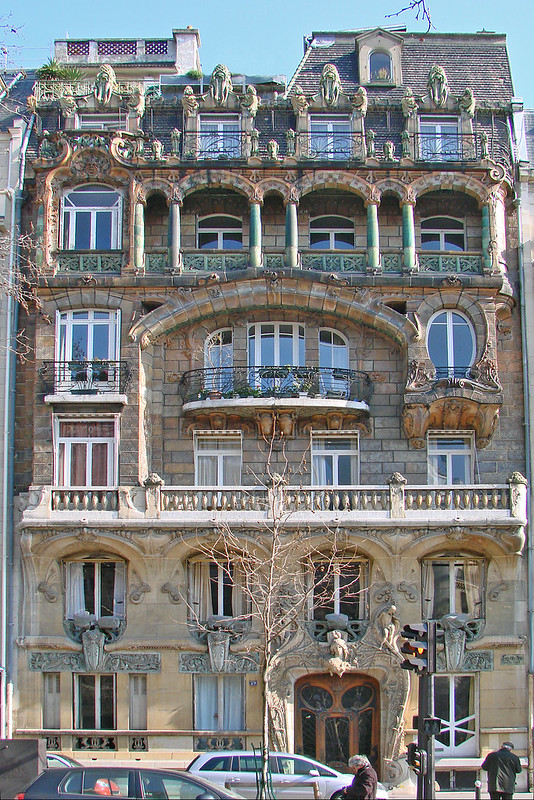There are reports that a new Paris Art Nouveau architecture museum may be in the cards.
Showcasing the work of hugely influential French architect Hector Guimard, it could become another cultural gem for our city.
We take a look at the history of Art Nouveau and the plans for the museum.
Paris and Art Nouveau
A walk around the historic streets of Paris rewards you with a multitude of architecture and styles. Everything from Hausmannian and Gothic to Classical and Belle Époque.
But one of the most frequent sights is the cast iron gates to the city’s subway stations – known here as the Métro.
These elaborate Art Nouveau (‘new art’) gates are the work of architect Hector Guimard, built between 1900 to 1913.
More than a century later, they continue to be a symbol of Paris. Of the original 141 gates, only 86 remain today – those that endure are now Historical Monuments.
For many, they are the epitome of the Art Nouveau style – curved, organic shapes that use decorative motifs from nature such as plants and leaves.
In fact, they are so closely associated with the style, that French Art Nouveau is sometimes referred to as ‘Le Style Métro.’
© Jean-Pierre Dalbéra
The planned Paris Art Nouveau Architecture Museum
While the Métro stations might be a lasting part of Guimard’s artistic legacy, he left behind much more, designing over 50 buildings.
One is the Hôtel Mezzara, located in the 16th arrondissement (district) at 60 rue Jean de La Fontaine.
Although it’s called a ‘hotel,’ the Hôtel Mezzara is not a place where guests can stay the night. It’s a ‘Hôtel Particulier’ – a large private townhouse or mansion.
As the only Guimard building still owned by the French government, it’s the Hôtel Mezzara that is being put forward to house the new museum.
The plans have been around for a number of years now, lobbied for by Le Cercle Guimard, a not-for-profit historic preservation group.
The Hôtel Mezzara – a little history
Guimard designed the Hôtel Mezzara for his friend Paul Mezzara, a textile manufacturer.
Constructed from 1910 to 1911, it was a family home. But one that could also exhibit and sell Mezzara’s fabric designs.
That year, Mezzara and Guimard both became Vice Presidents of the Society of Decorator Artists. It’s clear they were at the top of Parisian art society.
Looking at the building from the street through modern eyes, you can instantly see its asymmetrical style.
Made of white and beige limestone, it doesn’t have the Haussmannian ‘cut stone’ look of its neighbors. Instead, it’s curved and has irregular windows – no two are the same.
Guimard didn’t just design the exteriors. His artistic touch is also seen throughout the interiors, including some of the furniture.
A large central hall with a skylight is the space where Mezzara exhibited his creations.
Guimard also designed the stained-glass windows and iron balustrades. A bespoke Art Nouveau sideboard, dining table, and chairs still take pride of place in the dining room. They are painstakingly made from pear wood – Guimard’s favorite.
© Steve Cadman
An uncertain future?
Even after all this artistic work, Mezzara only lived in the Hôtel Mezzara for two years.
By 1930, it was a school, and continued as one for several decades, before laying empty and pretty much abandoned.
The building was then given a modest restoration in the summer of 2006.
It was then used in the film Cheri, starring Michelle Pfeiffer, and later returned to use as a boarding school for a few years, before the doors closed once again.
Its future was far from certain – and the French government even listed it for sale for €7 million a few years back. Although it never found a buyer.
So, will this Historic Monument ever become a new Paris Art Nouveau architecture museum?
The building has remained closed to the public for a while now, and the government is inviting tenders for a long lease of 80 years. Meanwhile, the Cercle Guimard group is pushing to get their museum project off the ground.
So only time will tell…
Other landmark Guimard buildings in Paris
The Hôtel Mezzara and the iconic Métro gates are just two examples of Guimard’s distinctive Art Nouveau architecture you’ll find in Paris.
There are many more – including his former home also in the 16th – the Hôtel Guimard.
Guimard designed this building as a working home for him and his wife Adeline Oppenheim Guimard, an American painter from a wealthy family. So it had a painting studio, and offices for his architectural firm.
© CVB
Another hugely important Guimard creation is the Castel Beranger, the first Art Nouveau apartment building in Paris. In 1899, it won a competition as one of the best new building facades in the city.
© Steve Cadman
Also on rue Jean de la Fontaine, it is located at number 14, and is actually three buildings surrounding an inner courtyard – with 36 apartments in total.
This remains a private apartment complex to this day.
Another landmark Guimard building in the 16th is the Hotel Jassedé, an early Art Nouveau work located at 41 rue Chardon-Lagache. Designed when the architect was just 26, it shows his burgeoning style.
Important examples of Guimard’s work can also be found on the Left Bank. The well-known Immeuble Lavirotte is at 29 avenue Rapp in the 7th district.
© W. Brian Duncan
Stay up-to-date with 56Paris
While the Art Nouveau architecture museum is still just an idea at this stage, it would certainly be a welcome addition to the museums of Paris.
We will update our readers with any developments as they happen.
Until then, if you want to stay up-to-date with more Paris news, you can follow our social media channels on Facebook, X, Instagram, and Pinterest.
Or if you’d like to speak to one of our real estate experts, don’t hesitate to get in touch.
Photo: © Jean-Pierre Dalbéra
